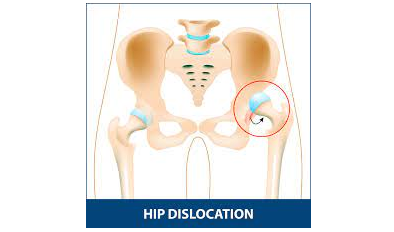A hip dislocation is a medical emergency! Call 911 ASAP. Do not move the injured person. If you yourself are the injured person, wait for help to arrive. It is a painful, traumatic event that occurs when the femur (ball and socket head of the thigh bone) is forced out of the acetabulum (the socket), thereby making it impossible to move the affected leg. It takes a major forceful impact, such as a fall from a higher elevation, a motor vehicle accident, a collision, or broken bones, to cause a hip dislocation. Seventy percent of hip dislocations are caused by motor vehicle accidents (MVA). Other causes include high impact sports like football, rugby, water and snow skiing, gymnastics, running, basketball, race car driving, and equestrian sports. Other possible injuries that occur during a hip dislocation are pelvic fracture, leg fracture, back fracture, abdominal, knee, and head injuries. When the hip dislocates, the ligaments, labrum, muscles, and other soft tissues holding the bones in place are often damaged. The nerves may be damaged as well, and patients may complain of loss of feeling in the foot or ankle area of the affected leg.
During a hip dislocation, the femoral head is either pushed backward (posterior dislocation) or forward (anterior dislocation) out of the socket. Posterior dislocation occurs in 90% of the cases and is very noticeable when the patient’s lower leg is in a fixed position with the knee and foot rotated inward toward the middle of the body. An anterior dislocation is evident when the hip is bent only slightly, and the leg is rotated out and away from the middle of the body. hip dislocation are uncommon during athletic events and rarely seen in younger individuals; yet, in November 2019, Tua Tagovailoa, a former starting quarterback for Alabama University and now the starting quarterback for the Miami Dolphins, experienced a season ending posterior hip dislocation with a posterior wall fracture.
Hip dislocation is a medical emergency
Treatment will include X-rays and computer topography (CT) scans of the hip. An orthopedic surgeon will perform an assessment in the emergency room, and surgery is typically necessary. Recovery time is usually 2-3 months for a hip to heal, and rehab time is longer if additional treatment is needed. Serious morbidity (disease) can be associated with hip dislocations; therefore, treatment must be diagnosed correctly and quickly to prevent avascular necrosis; unfortunately, osteoarthritis is likely to occur.

References
Alila Medical Media. (2020). [Illustration]. Read more
Gammons, M. (2018). Read more
OrthoInfo. (2020). Read more
